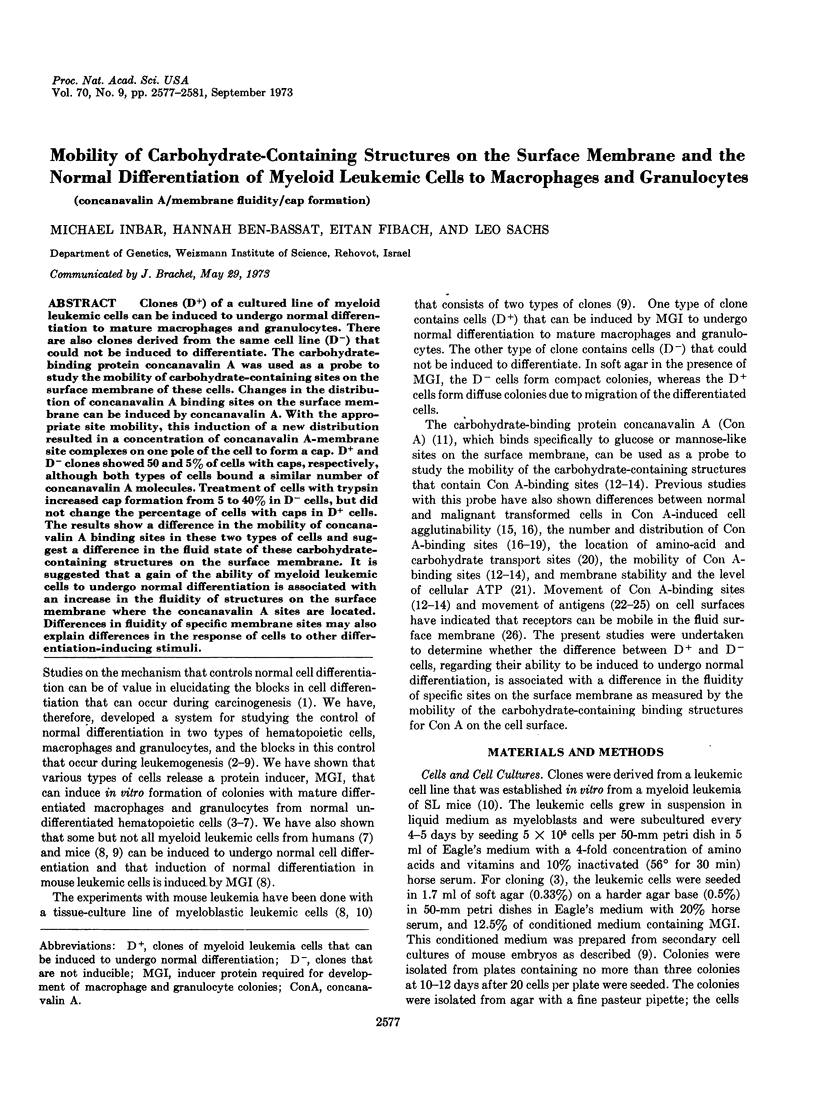Abstract
Clones (D+) of a cultured line of myeloid leukemic cells can be induced to undergo normal differentiation to mature macrophages and granulocytes. There are also clones derived from the same cell line (D-) that could not be induced to differentiate. The carbohydrate-binding protein concanavalin A was used as a probe to study the mobility of carbohydrate-containing sites on the surface membrane of these cells. Changes in the distribution of concanavalin A binding sites on the surface membrane can be induced by concanavalin A. With the appropriate site mobility, this induction of a new distribution resulted in a concentration of concanavalin A-membrane site complexes on one pole of the cell to form a cap. D+ and D- clones showed 50 and 5% of cells with caps, respectively, although both types of cells bound a similar number of concanavalin A molecules. Treatment of cells with trypsin increased cap formation from 5 to 40% in D- cells, but did not change the percentage of cells with caps in D+ cells. The results show a difference in the mobility of concanavalin A binding sites in these two types of cells and suggest a difference in the fluid state of these carbohydrate-containing structures on the surface membrane. It is suggested that a gain of the ability of myeloid leukemic cells to undergo normal differentiation is associated with an increase in the fluidity of structures on the surface membrane where the concanavalin A sites are located. Differences in fluidity of specific membrane sites may also explain differences in the response of cells to other differentiation-inducing stimuli.
Keywords: concanavalin A, membrane fluidity, cap formation
Full text
PDF




Images in this article
Selected References
These references are in PubMed. This may not be the complete list of references from this article.
- Edidin M., Weiss A. Antigen cap formation in cultured fibroblasts: a reflection of membrane fluidity and of cell motility. Proc Natl Acad Sci U S A. 1972 Sep;69(9):2456–2459. doi: 10.1073/pnas.69.9.2456. [DOI] [PMC free article] [PubMed] [Google Scholar]
- Fibach E., Hayashi M., Sachs L. Control of normal differentiation of myeloid leukemic cells to macrophages and granulocytes. Proc Natl Acad Sci U S A. 1973 Feb;70(2):343–346. doi: 10.1073/pnas.70.2.343. [DOI] [PMC free article] [PubMed] [Google Scholar]
- Fibach E., Landau T., Sachs L. Normal differentiation of myeloid leukaemic cells induced by a differentiation-inducing protein. Nat New Biol. 1972 Jun 28;237(78):276–278. doi: 10.1038/newbio237276a0. [DOI] [PubMed] [Google Scholar]
- GINSBURG H., SACHS L. FORMATION OF PURE SUSPENSIONS OF MAST CELLS IN TISSUE CULTURE BY DIFFERENTIATION OF LYMPHOID CELLS FROM THE MOUSE THYMUS. J Natl Cancer Inst. 1963 Jul;31:1–39. [PubMed] [Google Scholar]
- Ichikawa Y. Differentiation of a cell line of myeloid leukemia. J Cell Physiol. 1969 Dec;74(3):223–234. doi: 10.1002/jcp.1040740303. [DOI] [PubMed] [Google Scholar]
- Ichikawa Y., Pluznik D. H., Sachs L. In vitro control of the development of macrophage and granulocyte colonies. Proc Natl Acad Sci U S A. 1966 Aug;56(2):488–495. doi: 10.1073/pnas.56.2.488. [DOI] [PMC free article] [PubMed] [Google Scholar]
- Inbar M., Huet C., Oseroff A. R., Ben-Bassat H., Sachs L. Inhibition of lectin agglutinability by fixation of the cell surface membrane. Biochim Biophys Acta. 1973 Jul 18;311(4):594–599. doi: 10.1016/0005-2736(73)90132-6. [DOI] [PubMed] [Google Scholar]
- Inbar M., Sachs L. Interaction of the carbohydrate-binding protein concanavalin A with normal and transformed cells. Proc Natl Acad Sci U S A. 1969 Aug;63(4):1418–1425. doi: 10.1073/pnas.63.4.1418. [DOI] [PMC free article] [PubMed] [Google Scholar]
- Inbar M., Sachs L. Mobility of carbohydrate containing sites on the surface membrane in relation to the control of cell growth. FEBS Lett. 1973 May 15;32(1):124–128. doi: 10.1016/0014-5793(73)80753-7. [DOI] [PubMed] [Google Scholar]
- LOWRY O. H., ROSEBROUGH N. J., FARR A. L., RANDALL R. J. Protein measurement with the Folin phenol reagent. J Biol Chem. 1951 Nov;193(1):265–275. [PubMed] [Google Scholar]
- Landau T., Sachs L. Characterization of the inducer required for the development of macrophage and granulocyte colonies. Proc Natl Acad Sci U S A. 1971 Oct;68(10):2540–2544. doi: 10.1073/pnas.68.10.2540. [DOI] [PMC free article] [PubMed] [Google Scholar]
- Loor F., Forni L., Pernis B. The dynamic state of the lymphocyte membrane. Factors affecting the distribution and turnover of surface immunoglobulins. Eur J Immunol. 1972 Jun;2(3):203–212. doi: 10.1002/eji.1830020304. [DOI] [PubMed] [Google Scholar]
- Miller I. R., Great H. Protein labeling by acetylation. Biopolymers. 1972;11(12):2533–2536. doi: 10.1002/bip.1972.360111212. [DOI] [PubMed] [Google Scholar]
- Nicolson G. L. Topography of membrane concanavalin A sites modified by proteolysis. Nat New Biol. 1972 Oct 18;239(94):193–197. doi: 10.1038/newbio239193a0. [DOI] [PubMed] [Google Scholar]
- Pluznik D. H., Sachs L. The cloning of normal "mast" cells in tissue culture. J Cell Physiol. 1965 Dec;66(3):319–324. doi: 10.1002/jcp.1030660309. [DOI] [PubMed] [Google Scholar]
- Shoham J., Sachs L. Differences in the binding of fluorescent concanavalin A to the surface membrane of normal and transformed cells. Proc Natl Acad Sci U S A. 1972 Sep;69(9):2479–2482. doi: 10.1073/pnas.69.9.2479. [DOI] [PMC free article] [PubMed] [Google Scholar]
- Singer S. J., Nicolson G. L. The fluid mosaic model of the structure of cell membranes. Science. 1972 Feb 18;175(4023):720–731. doi: 10.1126/science.175.4023.720. [DOI] [PubMed] [Google Scholar]
- Sumner J. B., Howell S. F. Identification of Hemagglutinin of Jack Bean with Concanavalin A. J Bacteriol. 1936 Aug;32(2):227–237. doi: 10.1128/jb.32.2.227-237.1936. [DOI] [PMC free article] [PubMed] [Google Scholar]
- Vlodavsky I., Inbar M., Sachs L. Membrane changes and adenosine triphosphate content in normal and malignant transformed cells. Proc Natl Acad Sci U S A. 1973 Jun;70(6):1780–1784. doi: 10.1073/pnas.70.6.1780. [DOI] [PMC free article] [PubMed] [Google Scholar]
- Yahara I., Edelman G. M. Restriction of the mobility of lymphocyte immunoglobulin receptors by concanavalin A. Proc Natl Acad Sci U S A. 1972 Mar;69(3):608–612. doi: 10.1073/pnas.69.3.608. [DOI] [PMC free article] [PubMed] [Google Scholar]



